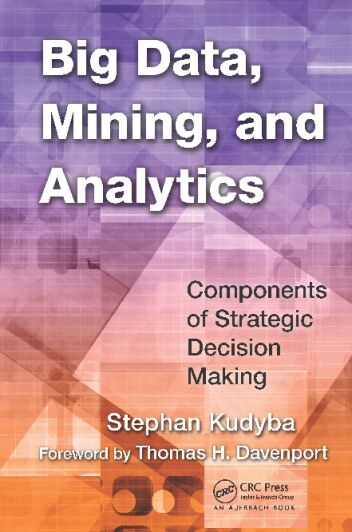书名:Big data, mining, and analytics
责任者:Stephan Kudyba ; foreword Thomas H. Davenport.
ISBN\ISSN:9781466568709,1466568704
出版时间:2014
出版社:Taylor & Francis
分类号:自动化技术、计算机技术
页数:xv, 305 p.
前言
Big data and analytics promise to change virtually every industry and business function over the next decade. Any organization that gets started early with big data can gain a significant competitive edge. Just as early analytical competitors in the “small data” era (including Capital One bank, Progressive Insurance, and Marriott hotels) moved out ahead of their competitors and built a sizable competitive edge, the time is now for firms to seize the big data opportunity.
As this book describes, the potential of big data is enabled by ubiqui-tous computing and data gathering devices; sensors and microproces-sors will soon be everywhere. Virtually every mechanical or electronic device can leave a trail that describes its performance, location, or state. These devices, and the people who use them, communicate through the Internet—which leads to another vast data source. When all these bits are combined with those from other media—wireless and wired telephony, cable, satellite, and so forth—the future of data appears even bigger.
The availability of all this data means that virtually every business or organizational activity can be viewed as a big data problem or initiative. Manufacturing, in which most machines already have one or more micro-processors, is increasingly becoming a big data environment. Consumer marketing, with myriad customer touchpoints and clickstreams, is already a big data problem. Google has even described its self-driving car as a big data project. Big data is undeniably a big deal, but it needs to be put in context.
Although it may seem that the big data topic sprang full blown from the heads of IT and management gurus a couple of years ago, the concept actually has a long history. As Stephan Kudyba explains clearly in this book, it is the result of multiple efforts throughout several decades to make sense of data, be it big or small, structured or unstructured, fast moving or quite still. Kudyba and his collaborators in this volume have the knowl-edge and experience to put big data in the broader context of business and organizational intelligence.
If you are thinking, “I only want the new stuff on big data,” that would be a mistake. My own research suggests that within both large non-online businesses (including GE, UPS, Wells Fargo Bank, and many other lead-ing firms) and online firms such as Google, LinkedIn, and Amazon, big PF\x • Foreword
data is not being treated separately from the more traditional forms of analytics. Instead, it is being combined with traditional approaches into a hybrid capability within organizations.
There is, of course, considerable information in the book about big data alone. Kudyba and his fellow experts have included content here about the most exciting and current technologies for big data—and Hadoop is only the beginning of them. If it’s your goal to learn about all the technologies you will need to establish a platform for processing big data in your orga-nization, you’ve come to the right place.
These technologies—and the subject of big data in general—are exciting and new, and there is no shortage of hype about them. I may have contrib-uted to the hype with a coauthored article in the Harvard Business Review called “Data Scientist: The Sexiest Job of the 21st Century” (although I credit the title to my editors). However, not all aspects of big data are sexy. I remember thinking when I interviewed data scientists that it was not a job I would want; there is just too much wrestling with recalcitrant data for my skills and tastes.
Kudyba and his collaborators have done a good job of balancing the sexy (Chapter 1, for example) and the realistic (Chapter 5, for example). The lat-ter chapter reminds us that—as with traditional analytics—we may have to spend more time cleaning, integrating, and otherwise preparing data for analysis than we do actually analyzing it. A major part of the appeal of big data is in combining diverse data types and formats. With the new tools we can do more of this combining than ever before, but it’s still not easy.
Many of the applications discussed in this book deal with marketing—using Internet data for marketing, enhancing e-commerce marketing with analytics, and analyzing text for information about customer senti-ments. I believe that marketing, more than any other business function, will be reshaped dramatically by big data and analytics. Already there is very strong demand for people who understand both the creative side of marketing and the digital, analytical side—an uncommon combination. Reading and learning from Chapters 6, 7, 10, and others will help to pre-pare anyone for the big data marketing jobs of the future.
Other functional domains are not slighted, however. For example, there are brief discussions in the book of the massive amounts of sensor data that will drive advances in supply chains, transportation routings, and the monitoring and servicing of industrial equipment. In Chapter 8, the role of streaming data is discussed in such diverse contexts as healthcare equipment and radio astronomy.
查看更多
目录
Foreword ix
About the Author xiii
Contributors xv
Introduction to the Big Data Era 1
Information Creation through Analytics 17
Big Data Analytics—Architectures, Implementation Methodology, and Tools 49
Data Mining Methods and the Rise of Big Data 71
Data Management and the Model Creation Process of Structured Data for Mining and Analytics 103
The Internet: A Source of New Data for Mining in Marketing 129
Mining and Analytics in E-Commerce 147
Streaming Data in the Age of Big Data 165
Using CEP for Real-Time Data Mining 179
Transforming Unstructured Data into Useful Information 211
Mining Big Textual Data 231
The New Medical Frontier: Real-Time Wireless Medical Data Acquisition for 21st-Century Healthcare and Data Mining Challenges 257
Index 307
查看更多
馆藏单位
中科院文献情报中心 中国农科院农业信息研究所



